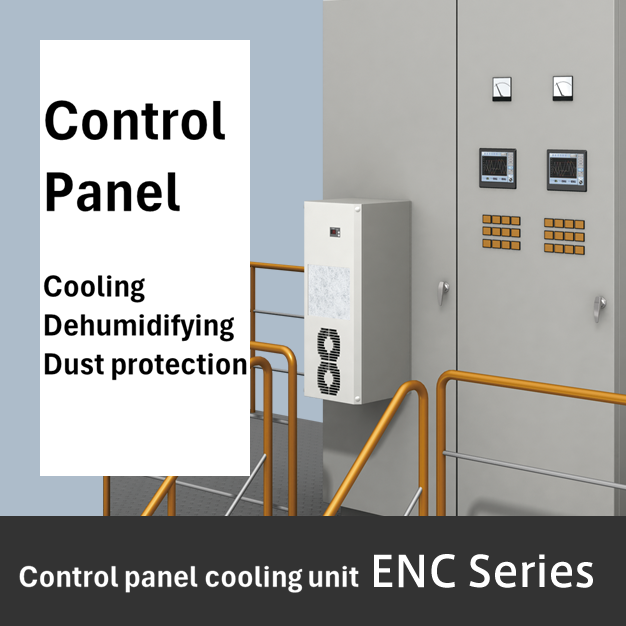Effective use of control panel cooling unit
Do not lower the temperature setting inside the panel too much
The lower the temperature in the board, the more time compressor it will run, and the more power consumption it will run. For example, electrolytic capacitors are not necessarily better if the temperature is low, since it is said that temperature life is no longer affected at temperatures below 30°C.
If the temperature inside the board is too low, on the contrary, the risk of condensation inside and outside panel increases.
Apiste In the following example, the temperature inside panel is initially set at 35°C as an appropriate standard.

Quick explanation: The risk of condensation
Condensation occurs due to the dew point temperature, which is caused by the temperature and humidity conditions near the surface of panel that is in contact with the air, and the temperature inside panel.
| Temperature and humidity outside the panel | Outside panel dew point temperature | Panel temperature setting | Condensation risk |
|---|---|---|---|
| 35℃ 70% | 28.7℃ | 25℃ | ○ |
| ↑ | ↑ | 35℃ | × |

Introducing heat problems in panel and key operational and energy-saving tips!
This book focuses on heat problems in panel, and provides information on the basics of heat problems, as well as a summary of some key points that can lead to efficient operation and energy conservation of panel.
Install the unit so that the exhaust heat from inside the panel and the cold air circulation path do not collide.
When the exhaust heat from the inverter and servo amplifier inside the panel comes into contact with the cold air from cooler, the cooling efficiency inside the panel decreases, resulting in cooler having to run for longer.
Ensure a cool air circulation path inside the panel. Avoid interference with the self-cooling fans of the equipment inside the panel.

If devices with self-cooling fans are concentrated on the top surface of the panel, select a bottom-blowing type.

Regular maintenance of filter, heat dissipation fins, heat dissipation fans, etc. will prevent a decline in cooling capacity.
cooling capacity of cooler depends on the amount of heat dissipated, so if cooling capacity is reduced due to regular maintenance in a dusty or oil mist environment, it will take longer to lower the temperature inside the panel, which will result in cooler running for longer and increasing power consumption.
Increase cooling efficiency inside the panel
- Stop the operation of ventilation fans, heat exchangers, etc., and make sure to seal off any air vents.
- Avoid short circuits within the board.

Effective energy-saving methods control panel cooling unit
Select an inverter model
In the case of conventional constant speed cooler, compressor operates at 100% when the desired temperature setting on the panel is exceeded. In the case of inverter type cooler, compressor speed is varied depending on the load factor and the difference with the desired temperature setting on the panel.
Inverter controls compressor

power consumption comparison data *For ENC-GR1500L-Pro

Select a model with ample cooling capacity
Selecting cooler with ample cooling capacity will result in shorter cooling operation time (operating rate).
In particular, with inverter-type cooler, if there is more cooling capacity available, the heat load rate will decrease, resulting in energy savings of up to 55 to 64%.
A quick explanation of the integrated power consumption
power consumption When considering the "total energy consumption", we must take into account the total energy consumption, which is the sum of operating hours and power consumption amount of energy consumed. The total energy consumption of an inverter model is much lower than that of a conventional model.
Select a model that has enough margin for the heat generated inside the panel.
ENC-GR1500L-Pro (rating cooling capacity 1460W) power consumption data
| Internal heat capacity (W) | 750 | 938 | 1125 | 1313 | 1500 |
|---|---|---|---|---|---|
| power consumption (W) | 333 | 407 | 574 | 738 | 779 |
power consumption When considering the "total energy consumption", we must take into account the total energy consumption, which is the sum of operating hours and power consumption amount of energy consumed. The total energy consumption of an inverter model is much lower than that of a conventional model.
[Test conditions] oil mist /dust was applied to cooler condenser by spray testing.
- Install cooler on a simulated panel with a heater inside
・Measure power consumption when the heater's heat output is changed
Ambient temperature and humidity: 35°C/40%, power-supply voltage: 200V

Energy saving with a generous selection

Introducing heat problems in panel and key operational and energy-saving tips!
This book focuses on heat problems in panel, and provides information on the basics of heat problems, as well as a summary of some key points that can lead to efficient operation and energy conservation of panel.






